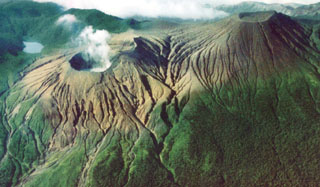Report on Rincon de la Vieja (Costa Rica) — 19 April-25 April 2023
Smithsonian Institution / US Geological Survey
Weekly Volcanic Activity Report, 19 April-25 April 2023
Managing Editor: Sally Sennert.
Please cite this report as:
Global Volcanism Program, 2023. Report on Rincon de la Vieja (Costa Rica) (Sennert, S, ed.). Weekly Volcanic Activity Report, 19 April-25 April 2023. Smithsonian Institution and US Geological Survey.
Rincon de la Vieja
Costa Rica
10.83°N, 85.324°W; summit elev. 1916 m
All times are local (unless otherwise noted)
OVSICORI-UNA reported that phreatic eruptions, detected seismically but often with observed emissions, continued to occur at Rincón de la Vieja during 18-25 April. Several eruptive events recorded during 18-21 April produced gas-and-steam emissions that rose as high as 1.5 km above the crater rim. A strong eruptive event at 1550 on 21 April generated a dense plume of material that rose 500 m above the crater rim and then collapsed, producing a pyroclastic flow and lahars on the N flank. A steam-and-gas plume with minor ash content rose 4-5 km above the crater rim. Strong tremor levels and near-continuous gas emissions were recorded after the event. That same day OVSICORI-UNA noted that during the previous week sulfur dioxide emissions were 221 tons per day on average, though emissions spiked to close to 5,000 tons per day after several of the phreatic events. During 22-24 April nearly continuous gas emissions continued to be visible and strong tremor continued to be recorded by the seismic network. Small phreatic events were recorded at 1904 on 22 April and at 0054 and 0629 on 24 April. Small phreatic events at 2250 on 23 April and 0630 on 24 April produced steam-and-gas plumes that rose no higher than 500 m above the crater rim.
Geological Summary. Rincón de la Vieja, the largest volcano in NW Costa Rica, is a remote volcanic complex in the Guanacaste Range. The volcano consists of an elongated, arcuate NW-SE-trending ridge constructed within the 15-km-wide early Pleistocene Guachipelín caldera, whose rim is exposed on the south side. Sometimes known as the "Colossus of Guanacaste," it has an estimated volume of 130 km3 and contains at least nine major eruptive centers. Activity has migrated to the SE, where the youngest-looking craters are located. The twin cone of Santa María volcano, the highest peak of the complex, is located at the eastern end of a smaller, 5-km-wide caldera and has a 500-m-wide crater. A Plinian eruption producing the 0.25 km3 Río Blanca tephra about 3,500 years ago was the last major magmatic eruption. All subsequent eruptions, including numerous historical eruptions possibly dating back to the 16th century, have been from the prominent active crater containing a 500-m-wide acid lake located ENE of Von Seebach crater.
Source: Observatorio Vulcanologico y Sismologico de Costa Rica-Universidad Nacional (OVSICORI-UNA)

